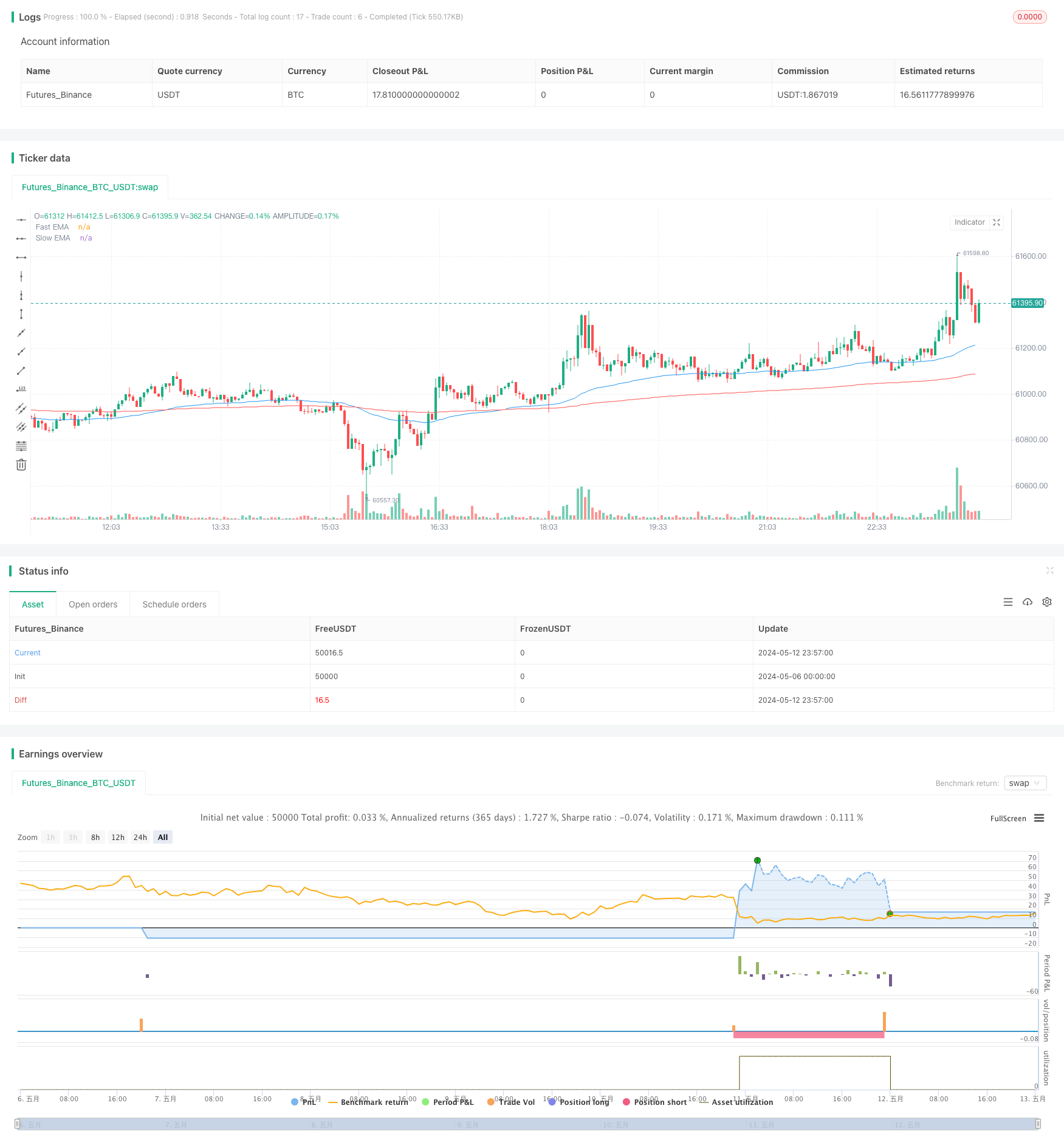
概述
该策略采用双EMA均线交叉作为交易信号,快线周期为65,慢线周期为240。同时使用成交量作为过滤条件,只有在当前成交量大于指定阈值时才会进行交易。策略对每笔交易设置固定风险金额(\(10),并根据风险金额动态计算仓位大小。当快线上穿慢线且成交量满足条件时做多,快线下穿慢线且成交量满足条件时做空。止损位和止盈位根据固定价格距离设置,做多时止损位在开仓价下方\)100,止盈位在开仓价上方\(1500;做空时止损位在开仓价上方\)100,止盈位在开仓价下方$1500。
策略原理
- 计算两条EMA均线,快线(ema_fast)周期为65,慢线(ema_slow)周期为240。
- 判断是否发生多头交叉(bullish_crossover)或空头交叉(bearish_crossover)。
- 设置成交量阈值(volume_threshold),只有当前成交量大于该阈值时才进行交易。
- 设置每笔交易的固定风险金额(risk_per_trade)为$10。
- 根据风险金额和止损距离(stop_loss_distance)计算仓位大小(position_size)。
- 当多头交叉发生且成交量满足条件时,开多仓,止损位设置在开仓价下方\(100,止盈位设置在开仓价上方\)1500。
- 当空头交叉发生且成交量满足条件时,开空仓,止损位设置在开仓价上方\(100,止盈位设置在开仓价下方\)1500。
策略优势
- 双均线交叉能够较好地捕捉到市场趋势,65/240周期组合可以过滤掉大部分噪音,只关注主要趋势。
- 引入成交量过滤条件,可以避免在成交量较低时交易,降低市场波动风险。
- 固定风险金额的仓位管理方式,能够有效控制每笔交易的风险敞口,避免单笔交易损失过大。
- 基于价格距离的动态止损和止盈设置,可以让盈利空间大于亏损空间,从而提高策略长期表现。
- 适用于BTC/USD等高波动品种,能够充分捕捉其波动带来的投资机会。
策略风险
- EMA作为趋势跟踪指标,存在趋势反转时滞后的问题,可能导致延迟入场或延迟出场。
- 固定风险金额可能无法动态适应市场波动情况,在极端行情下(如暴涨暴跌)表现欠佳。
- 成交量阈值的设置具有一定主观性,阈值设置不当可能影响策略效果。
- 止损位和止盈位的固定设置可能与市场实际波动幅度不匹配,导致频繁止损或止盈离场。
- 策略在震荡行情中表现可能欠佳,频繁交叉可能导致连续亏损交易。
策略优化方向
- 考虑引入更多均线组合作为过滤条件,如加入中期均线,构建多均线系统来提高信号可靠性。
- 优化仓位管理方式,如采用百分比风险法或凯利公式等动态调整仓位,以适应不同市场状态。
- 对成交量阈值进行参数优化,找到最佳阈值设置以提高策略稳定性。
- 优化止损止盈位置设置,根据最新市场波动情况实时调整,增加与市场相适应的灵活性。
- 在趋势型方法中加入一定的对冲成分,如PSAR等反趋势指标辅助判断,增强震荡市应对能力。
总结
该策略采用65/240双均线交叉作为趋势判断依据,同时结合成交量过滤条件来改进信号可靠性。固定风险仓位管理和固定价格止损止盈设置,可以一定程度上控制风险并让盈亏比倾向于有利方向。但策略也存在趋势把握相对滞后、仓位管理灵活性不足、止损止盈缺乏动态调整等问题。未来可以从构建多均线系统、优化仓位管理、动态止损止盈、引入对冲指标等角度对策略进行优化和改进,以期获得更加稳定和可靠的交易表现。
策略源码
/*backtest
start: 2024-05-06 00:00:00
end: 2024-05-13 00:00:00
period: 3m
basePeriod: 1m
exchanges: [{"eid":"Futures_Binance","currency":"BTC_USDT"}]
*/
//@version=5
strategy("EMA Crossover Strategy with 1:3 RR, Volume Filter, and Custom Stop Loss/Take Profit (BTC)", overlay=true, currency="USD", initial_capital=100)
// Define EMA lengths
ema_length_fast = 65
ema_length_slow = 240
// Calculate EMAs
ema_fast = ta.ema(close, ema_length_fast)
ema_slow = ta.ema(close, ema_length_slow)
// Define crossover conditions
bullish_crossover = ta.crossover(ema_fast, ema_slow)
bearish_crossover = ta.crossunder(ema_fast, ema_slow)
// Plot EMAs
plot(ema_fast, color=color.blue, title="Fast EMA")
plot(ema_slow, color=color.red, title="Slow EMA")
// Define volume filter
volume_threshold = 1000 // Adjust as needed
// Define risk amount per trade
risk_per_trade = 0.5 // $10 USD
// Calculate position size based on risk amount
stop_loss_distance = 100
take_profit_distance = 1500
position_size = risk_per_trade / syminfo.mintick / stop_loss_distance
// Execute trades based on crossovers and volume filter
if (bullish_crossover and volume > volume_threshold)
strategy.entry("Buy", strategy.long, qty=position_size)
strategy.exit("Exit", "Buy", stop=close - stop_loss_distance, limit=close + take_profit_distance)
if (bearish_crossover and volume > volume_threshold)
strategy.entry("Sell", strategy.short, qty=position_size)
strategy.exit("Exit", "Sell", stop=close + stop_loss_distance, limit=close - take_profit_distance)
相关推荐